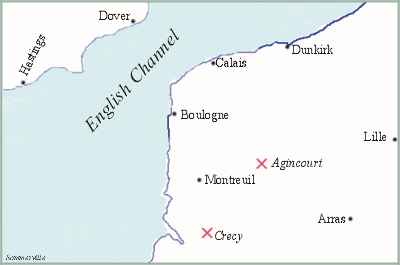Timeline of the Batte of Boulogne
Jump to navigation
Jump to search
| June 1544 | 42,000 English troops debarked at Calais, supported by 4,000 auxiliaries sent from Charles V and a number of mercenaries. The force divided, one section under Thomas Howard, 3rd Duke of Norfolk advancing against Montreuil on the Canche River due south of Calais, the other section under Charles Brandon, 1st Duke of Suffolk marching on the port city of Boulogne |
| July 19, 1544 | Norfolk's army pursued their siege only half-heartedly, while Suffolk's troops began a close investment of Boulogne. Charles protested that Henry was dawdling when he should be advancing on Paris, but Henry replied that the two towns were vital if he was to maintain his lines of supply. |
| July 26, 1544 | The siege of Boulogne became more intense when Henry arrived to take command of the 16,000-man force. The lower town was only lightly fortified, and Henry's troops captured it after a heavy bombardment. A Roman-era lighthouse, known as the "Old Man," also fell in the initial attack. |
| August, 1544 | The bombardment continued through August. |
| September 1, 1544 | Henry launched an assault against the main fortifications protecting the upper town. It was captured, but his men were unable to approach the city's castle. The French resistance and firepower were sufficiently intense to keep the English troops at bay for a time. For another two weeks, Henry's artillerists and engineers did their work, and mines under the castle walls created sufficient damage for the defenders to lose their resolve. |
| September 13, 1544 | The French asked for terms. |
| September 18, 1544 | King Henry accepted the surrender of the 1,630 surviving defenders when he entered the town in triumph. Meanwhile, the siege at Montreuil was making no progress. Rather than going there and taking command, Henry stayed in Boulogne, making plans to go home. While doing so, he learned that Charles V and Francis I had signed a peace treaty on 18 September, just as he was occupying Boulogne. In spite of this news, Henry returned home anyway, leaving Norfolk and Suffolk in France. Norfolk soon abandoned Montreuil, however, learning of the approach of a 30,000-man French army. He fled to Boulogne, then he and Suffolk fled again for Calais, leaving only 4,000 men to defend Boulogne. |
| October 7, 1544 | Francis and his army arrived before Henry's newly won city to see that the breaches the English artillery had created in the city walls had yet to be repaired |
| October 9, 1544 | Francis I decided to launch a night attack. He directed the twenty-three companies of French and Italian infantry to wear white shirts over their armor for greater visibility in the dark, giving this operation the nickname the "camisade of Boulogne." From some inexplicable reason the English were not paying attention to their defenses and the French easily broke into the city. Unfortunately, their operation began falling apart almost immediately. The assault commander was wounded and withdrew, just as rumors began to spread that the English had recaptured the breaches. Rather than retreat in an orderly fashion, the attackers instead abandoned all thoughts of fighting in favour of plunder. Sir Thomas Poynings, commanding the English forces in the citadel, rallied them and launched a counterattack that not only expelled the French forces, but also resulted in the loss of 800 French and Italian dead and prisoners. Francis abandoned the siege with the approach of winter, planning to return the following year. |
| 1545 | Without continental allies, Henry expected Francis to launch an invasion of England at the opening of the campaign season of 1545. He stationed three armies along the coast in preparation, but Francis launched little more than small-scale raids. Still, it was enough of a distraction to encourage the Scots to once again rise up and give Henry fits. At Boulogne, the French dug siege lines but did not commit sufficient men to the operation, while the 4,000 defenders were too few to drive the French away. Henry appointed two successive commanders to Boulogne, but neither proved successful in beating Francis' troops. Henry kept Boulogne, but it served him no useful purpose. |
| June 1546 | Henry and Francis I signed a peace treaty. Henry had assembled yet another invasion force, but in late spring changed his mind. "Perhaps the burden of war had crippled him; perhaps the desperate shortage of food which bad harvests brought in their train and his failure to raise victuals and enough munitions on the continent drove him to peace; perhaps Charles's evident intention to strike in Germany and thus ignore his erstwhile ally pulled him up; perhaps it was all of these things which now made imperative the discretion which the [Privy] Council had urged upon him with great vigour months before and had probably continued to urge thereafter" (Scarisbrick, Henry VIII, pp. 462-463). Still threatening an invasion, however, Henry was able to maintain possession of Boulogne for eight years, at which time it would be returned for a huge indemnity (which Henry was positive would never be paid). |
| Henry did get Francis I to sign the peace treaty giving him recognition as head of the Church of England and Ireland, so at least one domestic issue was positively addressed. |
SOURCES:
|
